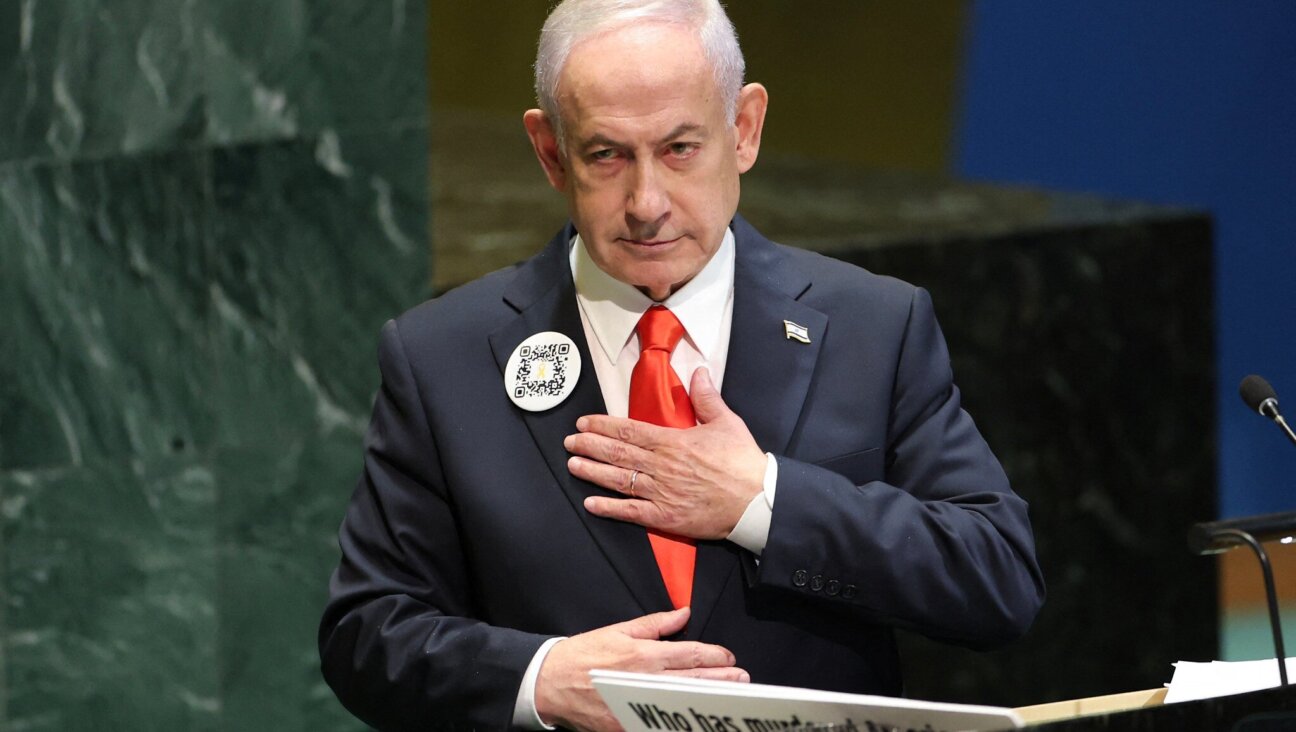Coming Full Circle on Triangle Factory Fire

Honoring a Memory: Performance artist Lulu Lolo (left) and Suzanne Pred Bass look over the handiwork of freshly created blouses and sashes created in memory of the victims of the 1911 fire. Image by Shulamit Seidler-Fuller
Among the volunteers who joined a sewing circle to remember the victims of the Triangle Waist Company fire 100 years ago, the talk around the table jumped from details of the historic blaze to an eerily similar fire that erupted in a garment factory in Bangladesh in December.
Several Remember the Triangle Fire Coalition members discussed the fire in a factory near Dhaka, Bangladesh, that killed at least 25 workers and injured another 100. More than a dozen trapped workers jumped to their deaths from the 10th floor to escape the blaze. The factory manufactured clothing to be distributed to the Gap and to J.C. Penney Co.
“Maybe we don’t smell the fire, but we get the ashes,” said Carmelina Cartei, head of the immigrant rights committee for the Triangle fire coalition.
Cartei, an adjunct women and gender studies professor at Hunter College, said the sewing circle and the coalition stood for more than just honoring the lives of those who died on March 25, 1911.
“I think we are also asking the question of, ‘Do we still have sweatshops?’ and in one way or another we do. We are in a sweatshop economy.”
Cartei was among about two dozen volunteers who gathered January 22 at the East Harlem home of a performance artist known as Lulu Lolo and her husband, Dan Evans, to make sashes and shirtwaists or blouses that will be used in the Triangle Factory Fire commemoration in March.
For Suzanne Pred Bass, joining the sewing circle brought back memories that hit close to home. Her great aunt, Rosie Weiner, was one of 146 victims, mostly Jewish and Italian immigrant women, who died in the flames that consumed three upper floors of the former Asch Building near Washington Square Park in what is still America’s worst industrial blaze.
Another great aunt, Katie Weiner, survived the inferno.
“Katie always talked about the fire, but she never talked about Rosie,” Pred Bass said. Katie, Rosie’s younger sister, survived by grabbing ahold of and sliding down the cable of the elevator car, so she could make her way down the building.
“It was so brave of her,” Pred Bass said, as she faced a large photograph of Rosie, then 19, that was on display in a room in the home that contains many mementos of the fire. Pred Bass held up a blouse and sash dedicated to her great aunt. “I think, as an older sister, [Rosie] might have gone back looking for Katie.… She might have lost her own life looking for Katie,” she said.
Like the fire in Bangladesh, many of the workers who were trapped by the flames in the Triangle fire jumped at least eight stories to their deaths, to the horror of onlookers below.
The Remember the Triangle Fire Coalition is a loose confederation of artists, authors, historians, performers, labor activists, safety engineers and others dedicated to commemorating the 100th anniversary. Dozens of events — including plays, art exhibitions, poetry readings and panel discussions — will be staged in New York City and in cities around the country to mark the event.
In East Harlem, the sewing circle members sat hunched over tables strewn with yards of donated fabric, lace and buttons. They used glue guns instead of thread, and the finished products were hung on wire hangers. The blouses will be placed on tall bamboo sticks that will be held by 146 volunteers who will march in a parade March 25.
Each blouse was draped with a sash bearing the name of a victim of the fire on the front and that victim’s age on the back. A number of the designs included long trims of cream-colored lace down the length of the arms; in the wind, the lace will have the intended effect of flailing arms. With each completed blouse, the women lifted up their handiwork to the approval of the others, some throwing out suggestions about the placement of a button or a ribbon.
Hanging on door frames and draped against the back of arm chairs and sofas, about 80 of the completed shirtwaists looked like a collection of beautiful works of art.
“It’s moving to me that Italian and Jewish women worked in the factory and now it’s Jewish and Italian women working for the centennial [commemoration],” said Annie Lanzillotto, an artist and writer who is heading the coalition’s outreach committee. But more than just honoring and remembering those who were killed, “we need to be accountable for where we export our work and our conditions,” she said. “These jobs are done by the same people, but on a different continent.”
Contact Maia Efrem at [email protected]

















